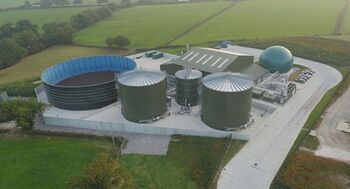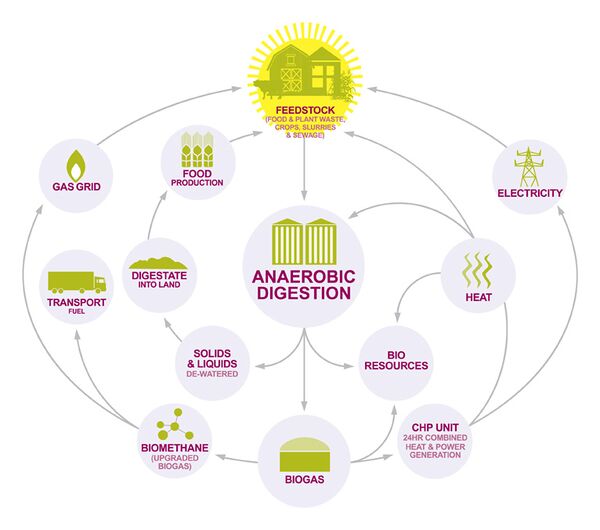Anaerobic Digestion: Difference between revisions
mNo edit summary |
add page specific text |
||
| Line 1: | Line 1: | ||
[[Category:Technologies & Solutions]] | [[Category:Technologies & Solutions]] | ||
'''Anaerobic Digestion''' (AD) is a process where biodegradable material is broken down by microorganisms in the absence of oxygen in an enclosed vessel. The process produces | '''Anaerobic Digestion''' (AD) is a process where biodegradable material is broken down by microorganisms in the absence of oxygen in an enclosed vessel. The process produces a [[Biogas]] which can be used for generating renewable power and a nutrient-rich solid/liquor known as [[digestate]] which can be used as fertiliser and compost. Anaerobic Digestion uses biodegradable waste materials from [[Agricultural Waste]] such as manure and slurry, [[Food Waste]] and [[Sewage Sludge]]. Where the process utilises [[Animal By-product Material]], it must comply with the [[Animal By-Products (Enforcement) (England) Regulations 2011]] requirements. | ||
[[File:Biogen AD plant.jpg|350px|left|Biogen Ad Plant in Gwynedd 11,500 tonnes of food waste per year - source Biogen.co.uk]]__TOC__ | |||
<br clear='left'/> | |||
==Overview== | |||
'''Anaerobic Digestion''' (AD) is a process where biodegradable material is broken down by microorganisms in the absence of oxygen in an enclosed vessel. The process of AD occurs in several stages and requires a community of micro-organisms: | |||
# Hydrolysis - large, complex polymers like carbohydrates, cellulose, proteins and fats are broken down by hydrolytic enzymes into simple sugars, amino acids and fatty acids. | |||
# Acidogenesis - simple monomers are broken down into volatile fatty acids | |||
# Acetogenesis - the products of acidogenesis are broken down into acetic acid, releasing hydrogen and carbon dioxide. | |||
# Methanogenesis - bacteria called methane formers produce methane either by cleaving two acetic acid molecules to form carbon dioxide and methane, or by reduction of carbon hydroxide with hydrogen <ref>http://www.biogas-info.co.uk/about/ad/</ref> | |||
[[File:NEW AD diagram LR.jpg|600px|left|The AD Cycle - Reproduced form the ABDA website www.abdabioresources.org/about-ad/what-is-it/]] | |||
<br clear='left'/> | |||
===Feedstock=== | |||
Anaerobic Digestion uses biodegradable waste materials from [[Agricultural Waste]] such as manure and slurry, [[Food Waste]] and [[Sewage Sludge]]. Where the process utilises [[Animal By-product Material]], it must comply with the [[Animal By-Products (Enforcement) (England) Regulations 2011]] requirements. | |||
===Biogas=== | |||
The process produces a [[Biogas]] which is around 60% methane, 40% carbon dioxide and traces of other contaminant gas (depending on the feedstock being digested). [[Biogas]] can be combusted to provide heat, electricity, or both. Alternatively the [[Biogas]] can be 'upgraded' to pure methane, often called biomethane, by removing other gases. This pure stream of biomethane can then be injected it into the mains gas grid or used as a road fuel. One cubic metre of [[biogas]] at 60% methane content converts to 6.7 kWh energy<ref>http://www.biogas-info.co.uk/about/biogas/</ref>. | |||
===Digestate=== | |||
[[Digestate]] is a nutrient-rich substance produced by AD that can be used as a fertiliser. It consists of left over indigestible material and dead micro-organisms - the volume of digestate will be around 90-95% of what was fed into the digester. Digestate is not compost, although it has some similar characteristics. In order for the material to no longer be considered as waste and be used as a fertiliser, the digestate must meet the standards set out in the Quality protocol and [[PAS110]]<ref>[http://www.wrap.org.uk/content/bsi-pas-110-specification-digestate [[WRAP]] Website With Link to Download]</ref> ([[SEPA]] position statement in Scotland<ref>http://www.biofertiliser.org.uk/pdf/SEPA-Position-Statement.pdf</ref>) | |||
==Process Options== | |||
The process options are varied to manage the AD stages into the following classifications: | |||
* Mesophilic or Thermophilic - operating at 25 to 45<sup>o</sup>C and 50 to 60<sup>o</sup>C respectively, the majority are Thermophilic in the UK | |||
* Wet or dry | |||
* Continuous or batch flow - the majority are continuous flow in the UK | |||
* Single, double or multiple digesters - most are single or double in the UK and can manage the stages more efficiently | |||
* Vertical tank or horizontal plug flow<ref>http://www.biogas-info.co.uk/about/ad/</ref> | |||
==Growth in Anaerobic Digestion== | |||
==Number of UK Sites== | |||
==References== | ==References== | ||
<references /> | <references /> | ||
Revision as of 16:29, 11 May 2020
Anaerobic Digestion (AD) is a process where biodegradable material is broken down by microorganisms in the absence of oxygen in an enclosed vessel. The process produces a Biogas which can be used for generating renewable power and a nutrient-rich solid/liquor known as digestate which can be used as fertiliser and compost. Anaerobic Digestion uses biodegradable waste materials from Agricultural Waste such as manure and slurry, Food Waste and Sewage Sludge. Where the process utilises Animal By-product Material, it must comply with the Animal By-Products (Enforcement) (England) Regulations 2011 requirements.

Overview
Anaerobic Digestion (AD) is a process where biodegradable material is broken down by microorganisms in the absence of oxygen in an enclosed vessel. The process of AD occurs in several stages and requires a community of micro-organisms:
- Hydrolysis - large, complex polymers like carbohydrates, cellulose, proteins and fats are broken down by hydrolytic enzymes into simple sugars, amino acids and fatty acids.
- Acidogenesis - simple monomers are broken down into volatile fatty acids
- Acetogenesis - the products of acidogenesis are broken down into acetic acid, releasing hydrogen and carbon dioxide.
- Methanogenesis - bacteria called methane formers produce methane either by cleaving two acetic acid molecules to form carbon dioxide and methane, or by reduction of carbon hydroxide with hydrogen [1]

Feedstock
Anaerobic Digestion uses biodegradable waste materials from Agricultural Waste such as manure and slurry, Food Waste and Sewage Sludge. Where the process utilises Animal By-product Material, it must comply with the Animal By-Products (Enforcement) (England) Regulations 2011 requirements.
Biogas
The process produces a Biogas which is around 60% methane, 40% carbon dioxide and traces of other contaminant gas (depending on the feedstock being digested). Biogas can be combusted to provide heat, electricity, or both. Alternatively the Biogas can be 'upgraded' to pure methane, often called biomethane, by removing other gases. This pure stream of biomethane can then be injected it into the mains gas grid or used as a road fuel. One cubic metre of biogas at 60% methane content converts to 6.7 kWh energy[2].
Digestate
Digestate is a nutrient-rich substance produced by AD that can be used as a fertiliser. It consists of left over indigestible material and dead micro-organisms - the volume of digestate will be around 90-95% of what was fed into the digester. Digestate is not compost, although it has some similar characteristics. In order for the material to no longer be considered as waste and be used as a fertiliser, the digestate must meet the standards set out in the Quality protocol and PAS110[3] (SEPA position statement in Scotland[4])
Process Options
The process options are varied to manage the AD stages into the following classifications:
- Mesophilic or Thermophilic - operating at 25 to 45oC and 50 to 60oC respectively, the majority are Thermophilic in the UK
- Wet or dry
- Continuous or batch flow - the majority are continuous flow in the UK
- Single, double or multiple digesters - most are single or double in the UK and can manage the stages more efficiently
- Vertical tank or horizontal plug flow[5]
